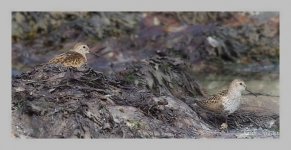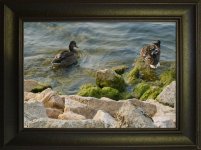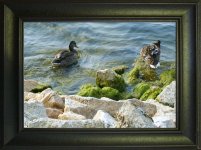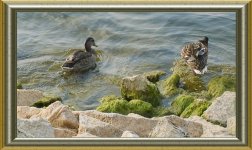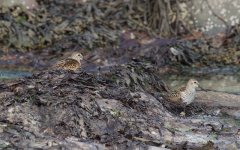-
Welcome to BirdForum, the internet's largest birding community with thousands of members from all over the world. The forums are dedicated to wild birds, birding, binoculars and equipment and all that goes with it.
Please register for an account to take part in the discussions in the forum, post your pictures in the gallery and more.
You are using an out of date browser. It may not display this or other websites correctly.
You should upgrade or use an alternative browser.
You should upgrade or use an alternative browser.
Is my lens big enough (1 Viewer)
- Thread starter CBB
- Start date
More options
Who Replied?IanF
Moderator
300mm should be just fine to use. You can never get enough reach for bird photos and I find even a 400mm lens can be very restricting. However I've seen hudreds of top quality bird photos taken with 300mm and even 200 mm lenses. If you pick your situations carefully then even 300mm gets you close enough for garden birds, hides and feeding stations etc.
You may even be able to add a 1.4x or a 2x teleconverter which should give all the reach you need.
You may even be able to add a 1.4x or a 2x teleconverter which should give all the reach you need.
christineredgate
Winner of the Copeland Wildlife Photographer of th
If you type 300 lens into a Gallery search you should find lots of images taken with a 300 lens.
Keith Reeder
Watch the birdie...
Much depends on which 300mm lens though - what have you got, Chris?
You're in the "Sigma etc" forum, so it might be (say) the Sigma 70-300mm APO zoom., which is an nice little kens, but not at the top of most people's bird lens lists (great for general shooting, macros etc though): or the Sigma 100-300mm F4, which is a fantastic lens, and well able to do whatever is asked of it, quality-wise, and it will take a 1.4x converter very well too, giving you a 420mm/f 5.6 lens.
It also depends what you mean by "decent photography" - bird photos? General use? Portraits? Macro?
You're in the "Sigma etc" forum, so it might be (say) the Sigma 70-300mm APO zoom., which is an nice little kens, but not at the top of most people's bird lens lists (great for general shooting, macros etc though): or the Sigma 100-300mm F4, which is a fantastic lens, and well able to do whatever is asked of it, quality-wise, and it will take a 1.4x converter very well too, giving you a 420mm/f 5.6 lens.
It also depends what you mean by "decent photography" - bird photos? General use? Portraits? Macro?
Last edited:
Andrew Rowlands
Well-known member

To take an alternative view, Keith - we're in the third-party lens category, it could be made by any other maker.Keith Reeder said:Much depends on which 300mm lens though - what have you got, Chris?
You're in the "Sigma etc" forum, ...
Much also depends on the ability ('natural' or otherwise) and fieldcraft skills of the photographer.
Realistically, much will depend on the users own definitions of what sort of photographs they would like to make.
All that aside and, as we don't yet know if it's a zoom or not, don't forget that many memorable images have been taken on equipment that we would not even contemplate using in the field today. This may be a great opportunity to learn the basics, after all, it's only 'painting with light'.
Even if Chris doesn't take any 'good' pictures with this lens, it may just make him a better birder through trying to get close enough :t:
Keith Reeder
Watch the birdie...
Hi Andrew,Andrew Rowlands said:To take an alternative view, Keith - we're in the third-party lens category, it could be made by any other maker.
that's why I said (with my emphasis):
"so it might be (say) the Sigma 70-300mm" - I was just using Sigma (by far the most popular/best selling 3rd party brand) as an example to make a non brand-specific point.
Last edited:
yes and no... a 300mm lens will give you plenty of opportunities for good shots, and if you can add a 1.4x tc you'll get even more. However there will be times when a 300mm lens will be too short and you'll wish you had more - but this is true of all lenses, I use a 500mm and still want more reach at times.
CBB
Well-known member
Hi all,
Thanks for the help. It's a Sigma 100-300 lens. Don't think it's APO. I was hoping to take pictures of birds. How much are the teleconverters? I'm assuming that a 2x means my 300 turns to a 600 or am I being nieve?
Thanks
Chris
By the way, my ability would be classed as beginner. I'm just trying to see what I can do with it before I go for a digital SLR at Christmas.
Thanks for the help. It's a Sigma 100-300 lens. Don't think it's APO. I was hoping to take pictures of birds. How much are the teleconverters? I'm assuming that a 2x means my 300 turns to a 600 or am I being nieve?
Thanks
Chris
By the way, my ability would be classed as beginner. I'm just trying to see what I can do with it before I go for a digital SLR at Christmas.
Keith Reeder
Watch the birdie...
Hi Chris,
there are actually two Sigma 100-300mm lenses - this one and this one.
The former is a nice little lens, but the latter is a better option if you want to get into teleconverters.
You're right though - stick a 2x tcon on a 300mm lens and you've got 600mm focal length.
There's a bit more too it than that though, so I'd suggest not worrying too much about teleconverters to start with...
there are actually two Sigma 100-300mm lenses - this one and this one.
The former is a nice little lens, but the latter is a better option if you want to get into teleconverters.
You're right though - stick a 2x tcon on a 300mm lens and you've got 600mm focal length.
There's a bit more too it than that though, so I'd suggest not worrying too much about teleconverters to start with...
Last edited:
CBB
Well-known member
Keith Reeder said:Hi Chris,
there are actually two Sigma 100-300mm lenses - this one and this one.
The former is a nice little lens, but the latter is a better option if you want to get into teleconverters.
You're right though - stick a 2x tcon on a 300mm lens and you've got 600mm focal length.
There's a bit more too it than that though, so I'd suggest not worrying too much about teleconverters to start with...
Cheers again Keith,
My lens is the former. The second does look good. A clear case of lens envy for me. I'm going out later to try and get some shots of anything. You may see something (one day) in the gallery from me.
Chris
By the way. Like your pictures on your website. :clap:
Last edited:
Keith Reeder
Watch the birdie...
Thanks for the kind words about the site, Chris - I'm just a novice myself, so if I can muddle by, anyone can!

An important point to bear in mind is that essentially there are two kinds of bird photos.
You've got the "extreme close-up" examples, which are of course awfully impressive, but they often involve big, expensive lenses and/or remarkably co-operative birds (generalising to make a point here- no need to put me right about all the other situations that can result in close-ups! ); and there's the kind of picture where the bird form a part of the scene rather than the frame-filling focus of the whole image.
); and there's the kind of picture where the bird form a part of the scene rather than the frame-filling focus of the whole image.
Many of us are big fans of the "bird in context" type of picture, and the good news is that you don't always need super-telephoto lenses to get 'em.
Just thought I'd mention it - the fact is, some of the very best bird pictures in the Gallery fall into this category...
http://www.birdforum.net/pp_gallery/showphoto.php/photo/40296/sort/1/cat/all/page/1
http://www.birdforum.net/pp_gallery/showphoto.php/photo/99330/sort/1/cat/all/page/2
http://www.birdforum.net/pp_gallery/showphoto.php/photo/100055/sort/1/cat/all/page/4
http://www.birdforum.net/pp_gallery/showphoto.php/photo/99974/sort/1/cat/all/page/4
http://www.birdforum.net/pp_gallery/showphoto.php/photo/66338/sort/1/cat/all/page/5
An important point to bear in mind is that essentially there are two kinds of bird photos.
You've got the "extreme close-up" examples, which are of course awfully impressive, but they often involve big, expensive lenses and/or remarkably co-operative birds (generalising to make a point here- no need to put me right about all the other situations that can result in close-ups!
Many of us are big fans of the "bird in context" type of picture, and the good news is that you don't always need super-telephoto lenses to get 'em.
Just thought I'd mention it - the fact is, some of the very best bird pictures in the Gallery fall into this category...
http://www.birdforum.net/pp_gallery/showphoto.php/photo/40296/sort/1/cat/all/page/1
http://www.birdforum.net/pp_gallery/showphoto.php/photo/99330/sort/1/cat/all/page/2
http://www.birdforum.net/pp_gallery/showphoto.php/photo/100055/sort/1/cat/all/page/4
http://www.birdforum.net/pp_gallery/showphoto.php/photo/99974/sort/1/cat/all/page/4
http://www.birdforum.net/pp_gallery/showphoto.php/photo/66338/sort/1/cat/all/page/5
Last edited:
London Birder
Well-known member
some people say that size don't matter.
me? I just reckon it's better to have a biggun ... just in case.
me? I just reckon it's better to have a biggun ... just in case.
Keith Reeder
Watch the birdie...
Hi again Chris,
I've only owned an SLR of any sort since May last year, when I got my D70, so I'm only 14 months in - definitely still in nappies!

I see much room for improvement in my photographs, but I've got a grip on the basics, I've put a lot of effort into "learning" the cameras I own and I've worked very hard to develop a decent hand-holding technique (I never use a tripod).
But I realised very early on that a picture which might be fairly mundane in a technical sense can be made quite worthwhile by choosing an interesting crop - the composition of the thing can often make up for technical failings.
Bear in mind that (in my experience at least) those close-up shots that make us go "wow!" really only impress photographers - we understand how hard it can be to get those shots and relate to them on that level - whereas family, friends, colleagues, "the man in the street", will respond far more to the composition and overall look of a picture, because emotional content is far more accessible to a non-photographer than any pure technical merit the picture might have.
Put a bit of thought into the composition (and the "in context" shots I talk about are all about this) and you can really surprise yourself.
That little whitethroat on my splash page is a fair example, I think: a simple box crop around the bird would make for a very dull picture, but by putting some thought into it, putting the bird into its context, I've ended up with something which this novice at least, is pretty happy with.
The attached is a picture I took recently - again nothing special technically, but making the birds part of the landscape works quite nicely here. It suggests something about dunlin behaviour, and I like the way the composition leads from top left to bottom right.
Of course, I had no control over where the dunlin happened to be when I was looking for something to shoot, but when I saw them I realised straight away that a crop/composition something like this was an option: I really like this kind of picture, so I pressed the shutter.
Developing an "eye" is something you need to do regardless of the lens you're using, and in that respect, it hardly matters which lens you've got - but you do need to learn to understand its capabilities.
Again, I'm speaking as a relative beginner with no grander aspirations than to take the occasional picture that people respond well to: but I do get that sometimes, and usually with pictures where the bird is "in there somewhere".
A final thought. Photography isn't rocket science, and an understanding of the basics isn't hard to come by with a bit of effort. But that won't automatically translate to eye-catching pictures.
So stick at it. There will be discouragements, but by clicking away, you'll eventually start to see subtle improvements in the "raw material" (the picture that comes off the camera) which will make the subsequent work you do on the PC (post processing, cropping, etc.) so much more productive.
And learn to be be critical of your pictures: life gets even better when you get to the stage where you can take one look at a downloaded picture, realise straight away that no amount of post processing will give you a satisfying end result, and so you waste no time on it.
I've only owned an SLR of any sort since May last year, when I got my D70, so I'm only 14 months in - definitely still in nappies!
I see much room for improvement in my photographs, but I've got a grip on the basics, I've put a lot of effort into "learning" the cameras I own and I've worked very hard to develop a decent hand-holding technique (I never use a tripod).
But I realised very early on that a picture which might be fairly mundane in a technical sense can be made quite worthwhile by choosing an interesting crop - the composition of the thing can often make up for technical failings.
Bear in mind that (in my experience at least) those close-up shots that make us go "wow!" really only impress photographers - we understand how hard it can be to get those shots and relate to them on that level - whereas family, friends, colleagues, "the man in the street", will respond far more to the composition and overall look of a picture, because emotional content is far more accessible to a non-photographer than any pure technical merit the picture might have.
Put a bit of thought into the composition (and the "in context" shots I talk about are all about this) and you can really surprise yourself.
That little whitethroat on my splash page is a fair example, I think: a simple box crop around the bird would make for a very dull picture, but by putting some thought into it, putting the bird into its context, I've ended up with something which this novice at least, is pretty happy with.
The attached is a picture I took recently - again nothing special technically, but making the birds part of the landscape works quite nicely here. It suggests something about dunlin behaviour, and I like the way the composition leads from top left to bottom right.
Of course, I had no control over where the dunlin happened to be when I was looking for something to shoot, but when I saw them I realised straight away that a crop/composition something like this was an option: I really like this kind of picture, so I pressed the shutter.
Developing an "eye" is something you need to do regardless of the lens you're using, and in that respect, it hardly matters which lens you've got - but you do need to learn to understand its capabilities.
Again, I'm speaking as a relative beginner with no grander aspirations than to take the occasional picture that people respond well to: but I do get that sometimes, and usually with pictures where the bird is "in there somewhere".
A final thought. Photography isn't rocket science, and an understanding of the basics isn't hard to come by with a bit of effort. But that won't automatically translate to eye-catching pictures.
So stick at it. There will be discouragements, but by clicking away, you'll eventually start to see subtle improvements in the "raw material" (the picture that comes off the camera) which will make the subsequent work you do on the PC (post processing, cropping, etc.) so much more productive.
And learn to be be critical of your pictures: life gets even better when you get to the stage where you can take one look at a downloaded picture, realise straight away that no amount of post processing will give you a satisfying end result, and so you waste no time on it.
Attachments
Last edited:
CBB
Well-known member
Hi Keith,
Sorry to keep asking so many questions. When you say crop, do you just mean make the original photo smaller, cutting out the parts of the background? Or do you somehow super-impose the pictures of the birds onto a separate background?
This is from Rutland Water. It's my daughters little digital camera. I've had a go.
Did the frame change. (see the 3rd pic) Will now move to one of the photo forums. Like the idea of being on 'a level'.
Sorry to keep asking so many questions. When you say crop, do you just mean make the original photo smaller, cutting out the parts of the background? Or do you somehow super-impose the pictures of the birds onto a separate background?
This is from Rutland Water. It's my daughters little digital camera. I've had a go.
Did the frame change. (see the 3rd pic) Will now move to one of the photo forums. Like the idea of being on 'a level'.
Attachments
Last edited:
Keith Reeder
Watch the birdie...
Hi Chris,
cropping is just "chopping off" those bits of the image that you don't want in the final composition - I've attached a resized version of the original dunlin pic so you can see the "before and after".
Admittedly I didn't crop a lot off this one, but by taking something of the top and bottom of the original and making this "letter box" crop I got the look I was after.
cropping is just "chopping off" those bits of the image that you don't want in the final composition - I've attached a resized version of the original dunlin pic so you can see the "before and after".
Admittedly I didn't crop a lot off this one, but by taking something of the top and bottom of the original and making this "letter box" crop I got the look I was after.
Attachments
Keith Reeder
Watch the birdie...
Aye, that's the kind of thing, Chris.
From a compositional point of view it's normally better to be more on the level of the bird(s) rather than looking down on them, but your mallard pic is just what people mean about making the bird part of the overall scene.
The frame is a bit overpowering, I reckon - try it again with a smaller, less "in your face" frame.
From a compositional point of view it's normally better to be more on the level of the bird(s) rather than looking down on them, but your mallard pic is just what people mean about making the bird part of the overall scene.
The frame is a bit overpowering, I reckon - try it again with a smaller, less "in your face" frame.
Cudyll Bach
Well-known member

Only just discovered this thread but you make an interesting point. I too like to take a little time in composing my photos if I can. Personally I think there is more artistic licence involved and now with Photoshop readily available, cropping has now come out of the darkroom. Ask yourself this, how many paintings/drawings of birds do you see that are of the extreme close-up kind? I think you will find the answer is very few.
Quacker
Well-known member
I agree to a point Iain. They may be very few, but they are the most respected/desired/favoured/satisfying shots. We all dream of the frame-filler.
By the way, Keith has a great advantage over the rest of us....
His best mate is a taxidermist, and a lot of his shots are, well, "static".
The Dunlin were static and stuck into the sand and rocks :-O
Damn! that's my pm advice over lol.
By the way, Keith has a great advantage over the rest of us....
His best mate is a taxidermist, and a lot of his shots are, well, "static".
The Dunlin were static and stuck into the sand and rocks :-O
Damn! that's my pm advice over lol.
Similar threads
Users who are viewing this thread
Total: 2 (members: 0, guests: 2)




